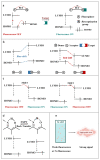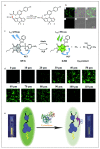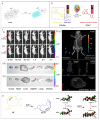Fluorescent Organic Small Molecule Probes for Bioimaging and Detection Applications
- PMID: 36500513
- PMCID: PMC9737913
- DOI: 10.3390/molecules27238421
Fluorescent Organic Small Molecule Probes for Bioimaging and Detection Applications
Abstract
The activity levels of key substances (metal ions, reactive oxygen species, reactive nitrogen, biological small molecules, etc.) in organisms are closely related to intracellular redox reactions, disease occurrence and treatment, as well as drug absorption and distribution. Fluorescence imaging technology provides a visual tool for medicine, showing great potential in the fields of molecular biology, cellular immunology and oncology. In recent years, organic fluorescent probes have attracted much attention in the bioanalytical field. Among various organic fluorescent probes, fluorescent organic small molecule probes (FOSMPs) have become a research hotspot due to their excellent physicochemical properties, such as good photostability, high spatial and temporal resolution, as well as excellent biocompatibility. FOSMPs have proved to be suitable for in vivo bioimaging and detection. On the basis of the introduction of several primary fluorescence mechanisms, the latest progress of FOSMPs in the applications of bioimaging and detection is comprehensively reviewed. Following this, the preparation and application of fluorescent organic nanoparticles (FONPs) that are designed with FOSMPs as fluorophores are overviewed. Additionally, the prospects of FOSMPs in bioimaging and detection are discussed.
Keywords: bioimaging; detection; fluorescent organic nanoparticles; fluorescent organic small molecules; recognition mechanisms.
Conflict of interest statement
The authors declare no conflict of interest.
Figures










Similar articles
-
Activatable NIR-II organic fluorescent probes for bioimaging.Theranostics. 2022 Apr 11;12(7):3345-3371. doi: 10.7150/thno.71359. eCollection 2022. Theranostics. 2022. PMID: 35547762 Free PMC article. Review.
-
Small-molecule fluorophores and fluorescent probes for bioimaging.Pflugers Arch. 2013 Mar;465(3):347-59. doi: 10.1007/s00424-013-1234-z. Epub 2013 Feb 15. Pflugers Arch. 2013. PMID: 23412659 Review.
-
Fluorescent covalent organic frameworks - promising bioimaging materials.Mater Horiz. 2024 May 7;11(9):2077-2094. doi: 10.1039/d3mh01698f. Mater Horiz. 2024. PMID: 38436072 Review.
-
Recognition Moieties of Small Molecular Fluorescent Probes for Bioimaging of Enzymes.Acc Chem Res. 2019 Jul 16;52(7):1892-1904. doi: 10.1021/acs.accounts.9b00214. Epub 2019 Jun 20. Acc Chem Res. 2019. PMID: 31243972
-
Recent Progress of Photoswitchable Fluorescent Diarylethenes for Bioimaging.Chembiochem. 2024 Dec 2;25(23):e202400326. doi: 10.1002/cbic.202400326. Epub 2024 Nov 6. Chembiochem. 2024. PMID: 39235968 Review.
Cited by
-
Signal Transduction Strategies for DNAzyme-Based Sensing and Imaging of Metal Ions in Cells and in Vivo.Chem Biomed Imaging. 2025 Mar 20;3(8):473-498. doi: 10.1021/cbmi.4c00090. eCollection 2025 Aug 25. Chem Biomed Imaging. 2025. PMID: 40880997 Free PMC article. Review.
-
Diverse Fluorescent Probe Concepts for Detection and Monitoring of Reactive Oxygen Species.Chem Asian J. 2025 Apr 3;20(7):e202401524. doi: 10.1002/asia.202401524. Epub 2025 Feb 20. Chem Asian J. 2025. PMID: 39924450 Free PMC article. Review.
-
Facile synthesis of N-doped graphene quantum dots as a fluorescent sensor for Cr(vi) and folic acid detection.RSC Adv. 2024 Aug 22;14(36):26667-26673. doi: 10.1039/d4ra05016a. eCollection 2024 Aug 16. RSC Adv. 2024. PMID: 39175673 Free PMC article.
-
Research Progress on Organic Fluorescent Probes Based on Pesticide Detection.J Fluoresc. 2025 Jul 10. doi: 10.1007/s10895-025-04440-6. Online ahead of print. J Fluoresc. 2025. PMID: 40640582 Review.
-
Recent Progress on Fluorescent Probes in Heavy Metal Determinations for Food Safety: A Review.Molecules. 2023 Jul 27;28(15):5689. doi: 10.3390/molecules28155689. Molecules. 2023. PMID: 37570660 Free PMC article. Review.
References
-
- Fukuto J.M., Carrington S.J., Tantillo D.J., Harrison J.G., Ignarro L.J., Freeman B.A., Chen A., Wink D.A. Small Molecule Signaling Agents: The Integrated Chemistry and Biochemistry of Nitrogen Oxides, Oxides of Carbon, Dioxygen, Hydrogen Sulfide, and Their Derived Species. Chem. Res. Toxicol. 2012;25:769–793. doi: 10.1021/tx2005234. - DOI - PMC - PubMed
-
- Griendling K.K., Touyz R.M., Zweier J.L., Dikalov S., Chilian W., Chen Y., Harrison D.G., Bhatnagar A., Amer H.A.C.B. Measurement of Reactive Oxygen Species, Reactive Nitrogen Species, and Redox-Dependent Signaling in the Cardiovascular System: A Scientific Statement From the American Heart Association. Circ. Res. 2016;119:E39–E75. doi: 10.1161/RES.0000000000000110. - DOI - PMC - PubMed
Publication types
MeSH terms
Substances
Grants and funding
- 52101287/National Natural Science Foundation of China
- U1806219/National Natural Science Foundation of China
- 2020GXRC019/Special Funding in the Project of the Taishan Scholar Construction Engineering and the program of Jinan Science and Technology Bureau
- 2020-370104-34-03-043952-01-11/New material demonstration platform construction project from Ministry of Industry and Infor-mation Technology
LinkOut - more resources
Full Text Sources

